Inversions and going upside down have become part of mainstream jiu-jitsu. There are now many techniques where you flip upside down temporarily to achieve your defensive or offensive goals
Now can you train BJJ without ever inverting? Absolutely! But can you compete at a high level without inverting? Probably not.
I think it’s safe to say that every high level competitive blackbelt today inverts at least occasionally. So it’s a manoeuvre and a tactic that you should be familiar with.
What is the Inverted Position?
The inversion looks a little bit like the ‘plough’ position in yoga, except that you usually don’t hang out there. Typically you’ll briefly be passing through this position on your way to somewhere else (and your arms will be in a more combative position too).
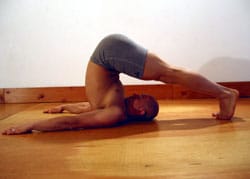
The Yoga Plough Position
When used in BJJ context that funky looking upside-down position is super versatile.
You’ll pass through it briefly in order to stop people from passing your guard, finish guard sweeps, set up submissions, escape bad positions, and take the back with techniques like the berimbolo and the crab ride..
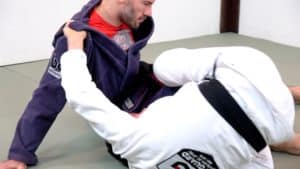
Inverting for a berimbolo backtake
In this article we’ll start with a whole bunch of examples of how inversions are used in BJJ (and how to do them safely). Then you’ll get 7 drills to make that movement smooth and instinctive.
Let’s start with the most important thing: not getting injured in the inversion…
Inverting Safely in BJJ
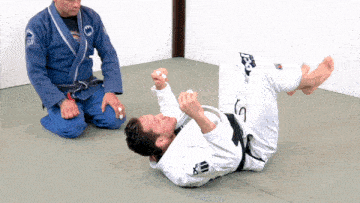
The Basic Inversion
First things first – you’ve got to be able to invert safely on your own before you can start doing it live.
For most people it takes a bit of time to develop this flexibility. You can develop this flexibility by doing both static stretching (the yoga ‘plough’ position is great for this) and by doing the dynamic drills that come slightly later in this article.
Once you’ve developed the minimum flexibility to achieve the basic inversion then the next step is to stay in good alignment.
Alignment in BJJ is defined as having base (the ability to generate and absorb force), posture (having your spine in good position), and structure (efficient positioning of your limbs). Click here for a detailed discussion of alignment with Rob Biernacki.
Here are some of the most important components of maintaining good alignment even though you’re upside down in the inverted position…
- Get your toes to the mat
- Spine is slightly rounded but still engaged – you want it to be slightly stiff so that it can bear weight
- Hinge your hips under control – you need to be able to get into the inverted position without using momentum
- Legs stay in base, and your arms frame against your legs to help bear some weight.
- Generally try to bring your nose to your knees and look the direction that you want to roll.
- Roll over your shoulders so that the weight isn’t sitting on your neck.
Applications of the Inversion Movement in BJJ
Inverting to Stop the Guard Pass (Three Examples)
The half Granby roll inversion is one of the two most important guard retention techniques you’ll use to stop your opponent from passing your guard.
In the half granby you’ll typically use a frame between you and your opponent to stop him from closing the distance, then invert up onto your shoulders in order to bring your legs back into position.
Here’s Rob Biernacki in The BJJ Formula breaking down the half Granby in a guard retention context…
Let’s take a look at another example of how an inversion can be used to stop the guard pass.
In this case we’ll look at the Toreando Guard Pass (aka Matador Pass) which is a very popular guard pass at every level in Brazilian jiu-jitsu.
Therefore if you do BJJ you absolutely need to know how to defend against it or you’ll end up on the bottom of side control every time!
Here’s Rory Van Vliet from The Guard Retention Formula showing how you can use the inversion to re-establish your frames and beat the grips that your opponent might have on your legs when he’s trying the Toreando on you….
And finally here’s an great example of how you can use an inversion to unwind your opponent’s grips when he’s smashing your legs together while passing your guard (from Non-Stop Jiu-Jitsu with Brandon Mullins)…
Inverting to Escape Side Control
There are a ton of different sidemount escapes involving shrimping, bridging, spinning, reguarding, etc.
But the reality is that not all sidemount escapes are created equal. Some work against white belts and blue belts, but mostly stop working at purple belt and above.
In fact when you watch high level BJJ competition you’ll see one specific sidemount escape more than any other.
Here’s a detailed video with Brandon Mullins from How to Defeat the Bigger, Stronger Opponent Series 2 about that exact escape.
In this escape you’re first seemingly going to do the wrong thing by turning away from your opponent, then use a brief inversion to re-establish guard…
Inverting to Attack with Upper Body Submissions
Not all uses of the inversion are defensive. You can also go upside down briefly in order to change the angles of an attack and dismantle your opponent’s defenses.
Here’s Keenan Cornelius (who was a guest on Episode 14 of The Strenuous Life Podcast way back) breaking down a spinning followup that he used to hit an armbar from half guard on Lucas Leite in competition.
Inverting to Attack with Lower Body Submissions
If you’re attacking with a leglock one of the worst things that can happen to you is you get smashed under your opponent. If he manages to get a crossface and drop his weight onto you then you’re going to suffer.
In this example grappling phenom Oliver Taza (with whom I shot No Gi Leglocks) shows you how you can use a brief inversion to get out of a smashed leglock position and turn the tables on your opponent.
This move resembles a tornado sweep from inverted guard but is a lot easier because you’re just lifting his leg, not his full weight, into the air.
I’m 50 years old and not crazy flexible anymore but I’ve used this technique many times in sparring with great success, so I can vouch for it 100%.
Here’s a step-by-step breakdown of how to enter into the Kani Basami and then finish in the full saddle with an applied heel hook…
Taking the Back using the Berimbolo
The berimbolo is one of those new-school techniques that you see people hit all the time at the purple, brown and black belt level.
(I’ve even seen someone pull it off in MMA.)
There are 3 steps to the basic berimbolo, namely, 1) getting your opponent’s butt to the mat, 2) spinning and inverting, 3) securing the back. Step 2 involves inverting under your opponent’s leg and spinning to bypass his guard and teleport to his back.
Check out the video below for what I think is a great introduction to the berimbolo and a cool way to drill the inversion…
Taking the Back with the Crab Ride
Another style of taking the back that has become very popular recently is the crab ride. It involves inverting under your opponent, gripping his hips or his belt with your hands, and controlling his legs with your legs. From this position you can climb to your opponent’s back or transition into other attacks and finishes.
The crab ride is a very versatile position and works in gi and no gi.
Here is a video I did with Matt Kwan in Modern Jiu-Jitsu giving you a great introduction to the crab ride…
Inversion Drills
Inversions can be a little tricky to figure out if someone is actively fighting back and/or has their weight on you.
So it can be a lot easier to develop the required movement and the flexibility if you drill them on their own first.
The 7 drills in this section are specifically designed to help you get more comfortable at going upside down in BJJ. You can use them as warmup drills, cool-down drills, or standalone skill development exercises that you can do alone at home.
Even if you NEVER go upside down on the ground you should still try these drills; they’re amazing for developing flexibility, spatial awareness, and core strength and we could all use a little more of that, couldn’t we?
The Backwards Shoulder Roll
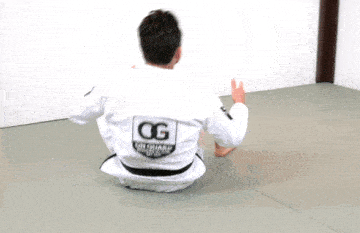
Backwards Shoulder Roll
The simplest form of the inversion is the basic backwards shoulder roll.
This is an absolutely essential movement in BJJ, and must be mastered by every single student.
The backwards shoulder roll is NOT the same as the backwards somersault you learned in grade school gym class! For example you don’t go straight back over your head (you go over one shoulder to keep your neck safe) and ideally you finish the roll on the balls of your feet in base so that you can proceed on to the next move.
The Pancake Roll
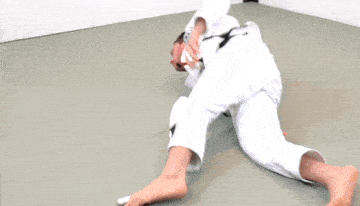
Pancake Roll
The pancake roll is a solo drill that takes you from your belly into an inverted position and back to your belly.
This isn’t a movement you’ll use often in grappling, but it’s a great way to develop body awareness, core stability and being comfortable in an inverted position.
The Compass Roll
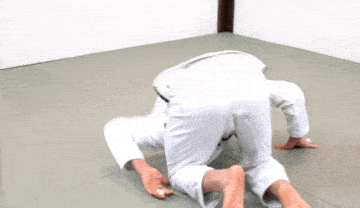
Compass Roll
The compass roll takes you from your knees, over your shoulders, and back to your knees. Very little weight goes onto your head and neck.
If you’re not familiar with inversions this drill looks a little fancy, but it’s actually relatively easy to do once you get it figured out.
The Tornado Roll
The tornado roll is a very combative movement. It’s essentially a Granby roll that you do on your own, and it translates directly to most of the inversion techniques you saw at the top of this article.
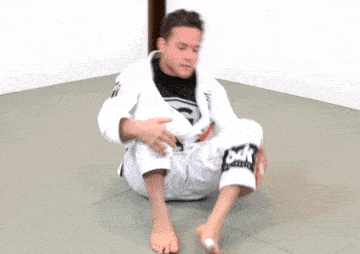
Half Tornado Roll
There are two variations of the tornado roll…
The half tornado roll (pictured above) takes you from your butt to an inverted position on your shoulders. Once you’re inverted you then roll towards your feet back to a seated position. You end up facing the opposite direction of where you started.
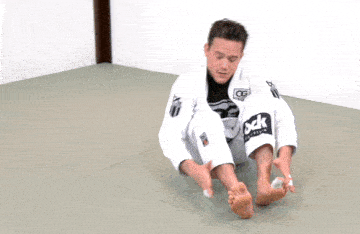
Full Tornado Roll
The full tornado roll takes you from a seated position to your shoulders just as with the half tornado roll, but now you continue the roll through to the other side until you end up back on your butt. At the end of the movement your feet are pointing in the same direction they were when you started.
The Tornado Roll Inversion on the Wall
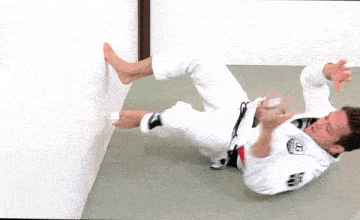
Tornado Roll on Wall
You can (and should) practice the tornado roll with your feet on a wall. This simulates having your feet in contact with your opponent and trains you to be able to invert using a different set of leverage points.
This is a cool looking drill but in some ways it’s easier than the original full tornado roll since because your feet are off the floor it requires slightly less flexibility.
Inverted Wall Shoulder Rolls
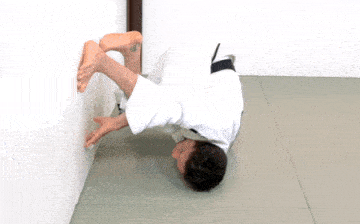
Inverted Wall Shoulder Rolls
Switching from side to side in an inverted position with your feet on the wall is an excellent simulation of the kind of weight shifting and lifting with your legs you need to do when you’re trying to get under your opponent in a position like the crab ride.
Inversion-Based Freeform Solo Flow
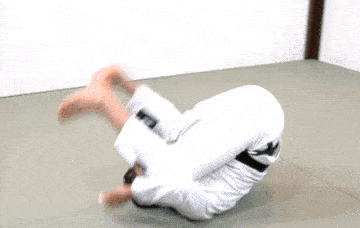
Inversion Flow Drill
Once you’ve become familiar with the 7 inversion movements above you can link them together into a freeform flow drill.
I hope these drills will be useful to make your back more flexible and maybe, just maybe, open up your mind to the possibility of occasionally going upside down in BJJ class.
Additional Resources
If you found this information interesting or useful then here are some other resources I’ve released that you may want to check out…
The Free Grapplearts BJJ Master App
The Grapplearts BJJ Master App is free to download and is available for both iOS and Android devices.
There’s a TON of free content in that app, so even if you never buy a single module it’ll still be a very valuable app on your phone.
It comes with hundreds of minutes and entire modules of free instruction, a player for my podcast, and links to my best articles
Click Below to Download The BJJ Master App Now For Free

A Formula for Guard Retention
The Guard Retention Formula is an instructional that I produced with my friend (and super-analytical BJJ black belt) Rory Van Vliet.
It’s a step-by-step system for making your guard incredibly difficult to pass. And it comes with a money-back 365 day guarantee if it doesn’t help you.
It’s available in DVD and Online Streaming format on Grapplearts, on Amazon.com in DVD form, and in app form on The Grapplearts BJJ Master App.
If you train BJJ then I think this is one of the most directly useful instructionals you can get.
The post A Primer for Inversions in BJJ appeared first on Grapplearts.


